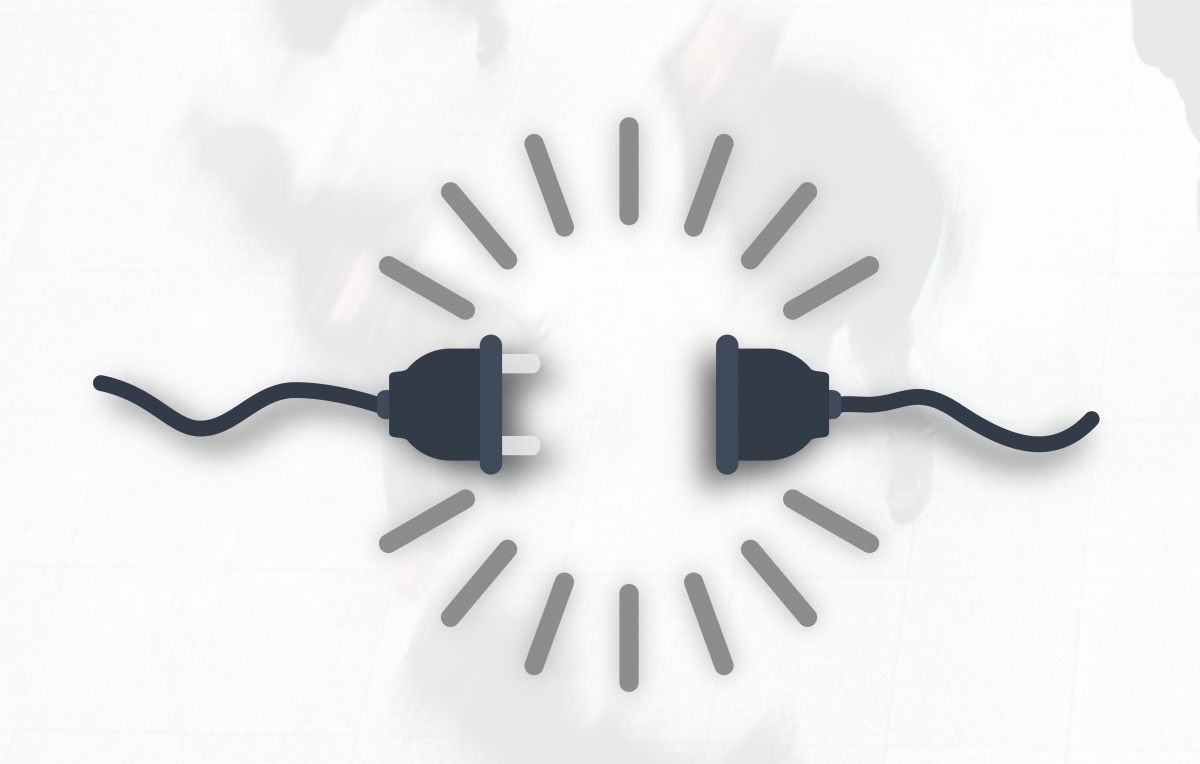The psychology of digital disconnection: Why we want to use digital media less and if we should even try to
Reviewer: Astrid Jansen
Editorial assitant: Ann-Katrin Hosch
Digital detox, digital minimalism, and smartphone free schools reveal a desire to reduce or change how we use technologies. However, disconnecting from digital communication like smartphones and social media is not always easy or beneficial. We discuss what digital disconnection is, why people desire less digitally mediated communication, and how disconnecting can be helpful as well as its limits.
 Image 1: ‘Unplugging’ could be a solution to negative consequences of digital media.
Image 1: ‘Unplugging’ could be a solution to negative consequences of digital media.
Too much of a good thing can be bad. Hence, we rest between exercises and take breaks when working. Increasing interest in concepts like self-optimization and digital well-being show that the same can apply to digital media [1]. Collectively, we send and receive hundreds of millions of WhatsApp messages every day [2] and spend several hours each day on social media, watching videos or playing games [3]. Many feel overwhelmed, believe they are wasting their time, or undermine authentic connections through such digital technologies. A potential solution might be to temporarily limit or adapt one’s digital technology use. For example, almost every second US American regularly limits their screen time and almost every third limits notifications [4].
As digital communication technologies become more integrated in our lives, positive as well as negative consequences may grow – or be perceived to grow – to similar extents. Claims frequently expressed in news media and public discourse about the “ruinous nature” of digital media for productivity, mental and physical health etc. are likely exaggerated and technologically deterministic in that they falsely assume strong media effects for all users under all types of circumstances when reality is more complex (for an overview see [5]). Nonetheless, there are indeed drawbacks associated with certain types of
social media and smartphone use, as well as certain features and content for some users – for example social comparisons in social networks tend to negatively affect well-being [6]. This
perception is omnipresent in public discourse, as is evident in news media and legislation, e.g. the EU Digital Services Act and legislation for the right to disconnect from online communication outside of work hours.
Scholars of digital well-being argue that there needs to be a balance between using digital technologies and disconnecting in order for users to achieve an optimal sense of
autonomy and to get the most out of the benefits of digital media [1]. Thus, choosing to engage in digital disconnection could be a potential solution to both reap the benefits and avoid the drawbacks of ubiquitous digital communication by temporarily, voluntarily, and selectively reducing digital media use.
What is digital disconnection?
When people digitally disconnect, they limit or selectively adapt their digital media use for certain periods of time. While digital disconnection is conceptualized in different ways, four aspects are central to its definition [5], [7], [8]:
First, digital disconnection is any behavioral or cognitive action taken towards non-use of aspects of digital media. This could be to put the smartphone away during in-person social interactions or to turn off notifications while focusing on other tasks.
Second, digital disconnection can take place across all levels of digital communication. Sometimes people prefer to temporarily get away from their phones or digital platforms altogether, while at other times they more selectively avoid certain accounts and content such as negative news or an annoying group chat.
Third, disconnection is most frequently viewed as voluntary disconnection. That means that it is self-initiated. Being cut-off from the mobile network in a remote location or lacking disposable income for a mobile data plan, for example, would not be viewed as digital disconnection.
Fourth, digital disconnection takes place over a certain period of time – i.e., there is a start and end point to the activity. This can be a very short and limited time, such as focusing on a task at hand, or a longer time, for example, doing a one-week challenge without a smartphone.
Reasons to disconnect
So, why do people reduce or attempt to reduce the time they spend with digital media or to adapt their usage?
Two major strands can be identified in research. On the one hand, deliberate disconnection can be viewed as a countermeasure to demands posed by digital capitalism–being deliberate of one’s attention is resistance in an attention economy [9].
Social media platforms, for example, design their products to keep users engaged. To regain user
autonomy, some in turn employ strategies for more mindful forms of use aimed at undermining structures or mechanisms of attention extraction, such as setting app time limits, using adblockers, etc.
On the other hand, disconnecting from digital media is often done for the purpose of self-optimization and productivity, such as focused work or improved well-being. When people use focus modes in digital devices, avoid content that is more pleasant than a task at hand, or turn on greyscale modes on their screens, they tend to do this with the
goal of improving their life by some measure.
Central within both strands is that individual needs are not met, or resources exceeded through the (over-)use of digital media. A balance between situational demands and individual resources, wants, and needs is in line with popular models of how stress and digital well-being arise in everyday life [1], [10]. When we are faced with an overwhelming number of e-mails, for example, this tends to cause stress on an already busy day. However, when we have the time and energy to respond to all of them, we do not feel stressed. Similarly, individuals view a certain amount of technology use as good or appropriate.
What constitutes a “good balance” is dependent on individual perceptions, norms, and types of digital media use. Different connection norms (e.g., to reply to messages fast) and disconnection norms (e.g., to not use the phone during meals) govern our increasingly mediated lives. Those expectations change across time but also along
gender, racial, and class lines [11], [12]. For example, smartphone use by mothers tends to be viewed as not paying enough attention to a child [12] and disconnecting is marketed as a commodity for the privileged [11]. Beyond that, they are also dependent on specific situations, e.g. when at lunch with coworkers vs. eating alone. The type of digital communication is also central to the individual assessment of the balance between connectivity and disconnectivity. We view watching TikTok videos very differently than writing a WhatsApp message. And we tend to worry about iPhone screen time a lot more than the time spent in front of a work laptop. Some of those perceptions are rooted in personal experience, whereas others stem from societal ideals, for instance, of productivity and self-optimization.
Effects of Disconnecting
 Image 3: Digital disconnection can be helpful but not for everyone under all circumstances.
Image 3: Digital disconnection can be helpful but not for everyone under all circumstances.
With all these reasons to disconnect, it could be expected that people generally feel better when they disconnect from digital media. However, this does not always seem to be the case – two reviews of the scientific literature on digital disconnection found partially conflicting results [7], [13]. Study participants experience and report a variety of positive effects when they participate in digital detox interventions or engage in self-initiated digital disconnection – such as less
procrastination, reduced stress, and improved sleep quality. Yet, the authors of the literature reviews highlight that digital disconnection can also be ineffective or even backfire and have negative consequences including increased fear of missing out or worse mood. One study argues that reducing digital connections can have undesirable consequences, especially for those with limited access to digital connection, such as adolescents in rural areas [14]. Nonetheless, experimentally prescribing disconnection could differ to how people would disconnect naturally on their own terms. Thus, some negative effects may be the result of the experimental methods used [7]. While several positive outcomes exist, the presence of undesirable effects shows that more studies are needed to investigate when disconnection can help and when it may not be beneficial for digital well-being.
Overall, current research does not indicate that digital disconnection is a panacea to potential issues with digital media that we face as individuals and as a society. Rather, the recommendation whether someone should reduce or adapt their use of digital media depends on individual needs and circumstances (see [15]) as well as social and material
factors such as income or changing norms around the use of digital communication [16]. While the effects of disconnecting are not yet fully understood, strategies and actions of digital disconnection can afford individuals more opportunities to self-regulate their use of digital media in an interconnected world.
Image 1: composite using works by Timon Studler (https://unsplash.com/de/fotos/menschen-die-tagsuber-auf-grauem-betonbode...) and Satheesh Sankaran (https://pixabay.com/vectors/plug-unplug-icon-unplugged-6183289/) under free licenses
Image 2: https://unsplash.com/photos/woman-in-green-tank-top-holding-smartphone-d...
Image 3: https://images.unsplash.com/photo-1469474968028-56623f02e42e?q=80&w=1474...
Bibliography
[1] M. M. P. Vanden Abeele, “Digital wellbeing as a dynamic construct,” Commun. Theory, vol. 31, no. 4, pp. 932–955, 2021, doi: 10.1093/ct/qtaa024.
[2] Facebook, “WhatsApp: daily sent message volume 2020,” Statista. Accessed: Nov. 28, 2023. [Online]. Available: https://www.statista.com/statistics/258743/daily-mobile-message-volume-o...
[3] “Digital 2023: Global overview report,” DataReportal – Global Digital Insights. Accessed: Nov. 29, 2023. [Online]. Available: https://datareportal.com/reports/digital-2023-global-overview-report
[4] J. Arbanas, P. H. Silverglate, S. Hupfer, J. Loucks, P. Raman, and M. Steinhart, “Consumers embrace connected devices and virtual experiences for the long term,” Deloitte Insights. Accessed: Apr. 11, 2024. [Online]. Available: https://www2.deloitte.com/us/en/insights/industry/telecommunications/con...
[5] A. Meier and L. Reinecke, “Computer-mediated communication,
social media, and mental health: A conceptual and empirical meta-review,” Commun. Res., vol. 48, no. 8, pp. 1182–1209, Dec. 2021, doi: 10.1177/0093650220958224.
[6] P. M. Valkenburg, “Social media use and well-being: what we know and what we need to know,” Curr. Opin. Psychol., vol. 45, p. 101294, 2022, doi: 10.1016/j.copsyc.2021.12.006.
[7] L.-M. Nassen, H. Vandebosch, K. Poels, and K. Karsay, “Opt-out, abstain, unplug. A systematic review of the voluntary digital disconnection literature,” Telemat. Inform., vol. 81, p. 101980, Jun. 2023, doi: 10.1016/j.tele.2023.101980.
[8] M. M. P. Vanden Abeele, A. Halfmann, and E. W. J. Lee, “Drug, demon, or donut? Theorizing the relationship between
social media use, digital well-being and digital disconnection,” Curr. Opin. Psychol., vol. 45, p. 101295, Jan. 2022, doi: 10.1016/j.copsyc.2021.12.007.
[9] T. Syvertsen and G. Enli, “Digital detox: Media resistance and the promise of authenticity,” Convergence, vol. 26, no. 5–6, pp. 1269–1283, Dec. 2020, doi: 10.1177/1354856519847325.
[10] R. S. Lazarus and S. Folkman, “Coping and adaption,” in The handbook of behavioural medicine, W. D. Gentry, Ed., Guilford, 1984, pp. 282–325.
[11] S. Van Bruyssel, R. De Wolf, and M. Vanden Abeele, “Who cares about digital disconnection? Exploring commodified digital disconnection discourse through a relational lens,” Converg. Int. J. Res. New Media Technol., p. 13548565231206504, Oct. 2023, doi: 10.1177/13548565231206504.
[12] L. N. Wolfers, R. Wendt, D. Becker, and S. Utz, “Do you love your phone more than your child? The consequences of norms and
guilt around maternal smartphone use,” Hum. Commun. Res., vol. 49, no. 3, pp. 285–295, Jun. 2023, doi: 10.1093/hcr/hqad001.
[13] T. Radtke, T. Apel, K. Schenkel, J. Keller, and E. Von Lindern, “Digital detox: An effective solution in the smartphone era? A systematic literature review,” Mob. Media Commun., vol. 10, no. 2, pp. 190–215, May 2022, doi: 10.1177/20501579211028647.
[14] K. N. Hampton and I. Shin, “Disconnection more problematic for adolescent
self-esteem than heavy
social media use: Evidence from access inequalities and restrictive media parenting in rural America,” Soc. Sci. Comput. Rev., vol. 2, no. 41, pp. 626–647, Jan. 2022, doi: 10.1177/08944393221117466.
[15] M. M. P. Vanden Abeele et al., “Why, how, when, and for whom does digital disconnection work? A process-based framework of digital disconnection,” Commun. Theory, p. qtad016, Jan. 2024, doi: 10.1093/ct/qtad016.
[16] S. Geber, M. H. Nguyen, and M. Büchi, “Conflicting norms—how norms of disconnection and availability correlate with digital media use across generations,” Soc. Sci. Comput. Rev., p. 08944393231215457, Nov. 2023, doi: 10.1177/08944393231215457.



